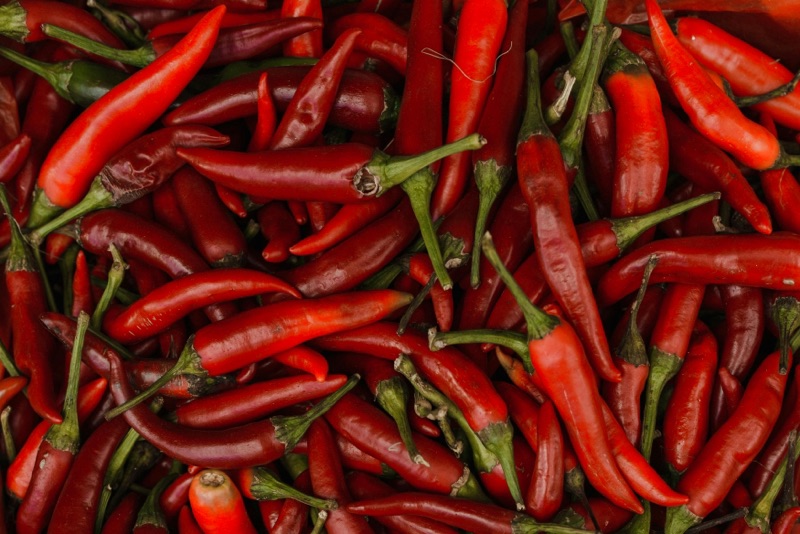Botanical Basics
- Common Name(s): Cayenne Pepper, Red Pepper, Guinea Spice, Bird Pepper
- Folk Name(s): Cow-Horn Pepper, African Pepper, Bird’s Tongue, Devil Pepper
- Scientific/Latin Name: Capsicum annuum (Cayenne type)
- Family: Solanaceae (Nightshade family)
- Plant Type: Perennial in warm climates; grown as an annual in temperate zones
- Botanical Description: Upright shrubby plant, 2–4 ft tall, with ovate, glossy green leaves and small white star-shaped flowers. Fruits are slender, elongated pods 2–5 inches long, ripening from green to bright red. Extremely pungent due to capsaicinoids.
- Growing Zones/Climate: Hardy in USDA zones 9–11; grown annually in zones 2–8. Prefers warm, frost-free climates.
- Best Zones for Growth: Southern U.S., South America, Africa, and Asia. Thrives in hot, humid, sunny environments.
- Habitat & Range: Native to Central & South America; cultivated worldwide as a spice and medicinal plant.
Cultivation & Harvest
- Soil & Sun Requirements: Prefers well-drained sandy or loamy soil, rich in organic matter; pH 6.0–7.0. Requires full sun (6–8+ hours).
- Propagation: Grown from seed; best started indoors 8–10 weeks before transplanting. Germination requires warmth (75–85°F).
- Companion Planting: Good companions include basil, carrots, onions, and parsley. Avoid planting near beans or brassicas.
- Harvesting Guidelines: Harvest peppers when fully red for maximum potency; use gloves to avoid skin irritation.
- Drying/Preservation: Can be air-dried, oven-dried, or strung into ristras. Once dried, powdered into cayenne spice. Stores well in airtight containers away from light.
Traditional & Historical Use
- Cultural Significance: A sacred spice in Mesoamerican cultures; used as food, medicine, and protection charm. Spread globally after the Columbian Exchange.
- Traditional Medicine: Indigenous peoples used cayenne for pain relief, circulation, and digestion. Ayurveda and TCM both value it for warming and stimulating qi/prana.
- Symbolism: Associated with vitality, strength, purification, and fiery transformation.
Medicinal & Practical Properties
- Active Constituents: Capsaicin, carotenoids, flavonoids, vitamin C, vitamin A, and essential oils.
- Medicinal Uses:
- Stimulates circulation and digestion
- Relieves muscle/joint pain topically
- Decongestant for colds and flu
- May lower blood pressure and improve heart health
- Increases metabolic activity
- Preparation Methods:
- Tinctures (alcohol or vinegar-based)
- Infused oils/liniments
- Capsaicin creams and salves
- Infused teas in very small amounts
- Dosage & Guidelines: Powdered cayenne: 30–120 mg capsules daily, or a pinch in tea/food. Always start with very small amounts.
- Safety/Precautions: Avoid contact with eyes or broken skin. High doses may cause gastric irritation. Not recommended for those with ulcers, GERD, or on blood-thinning medications.
Magical & Spiritual Properties
- Elemental Association: Fire
- Planetary/Deity Correspondence: Mars; associated with Sekhmet, Kali, and other fiery deities
- Magical Correspondences: Protection, courage, banishment, vitality, passion, quickening spells
- Ritual Use: Added to protection sachets, sprinkled around thresholds, used in banishing powders, or burned in incense for cleansing hostile energies.
- Symbolism in Divination/Dreams: Appearing in dreams may signal urgency, hidden anger, or the need for quick action.
Ecological & Culinary Uses
- Pollinator Value: Flowers attract bees and other pollinators.
- Wildlife Uses: Fruits deter many pests but may be eaten by birds (who are unaffected by capsaicin).
- Culinary Uses:
- Ground into cayenne powder
- Used in hot sauces and chili pastes
- Preserved in vinegar or oil
- Adds heat and color to soups, stews, and meats
Household/Practical Uses
- Natural pest deterrent (powder sprinkled in gardens)
- Used in topical liniments for arthritis and sore muscles
- Incorporated into warming foot soaks or compresses
Fast Facts
- Quick Uses: Circulation stimulant, digestive aid, protection spells, pest deterrent
- Notable Traits: Heat comes from capsaicin, measured on the Scoville scale (Cayenne: ~30,000–50,000 SHU)
- Special Notes: Birds are immune to cayenne’s heat; seeds are dispersed by them in the wild

Supporting Notes
- Duke, James A. Handbook of Medicinal Herbs. CRC Press, 2002.
- Chevallier, Andrew. Encyclopedia of Herbal Medicine. DK Publishing, 2016.
- Grieve, Maud. A Modern Herbal. 1931.
- Tierra, Michael. Planetary Herbology. Lotus Press, 1988.
No comments:
Post a Comment